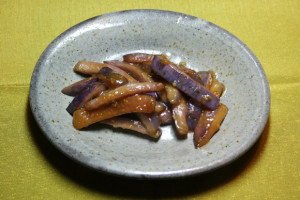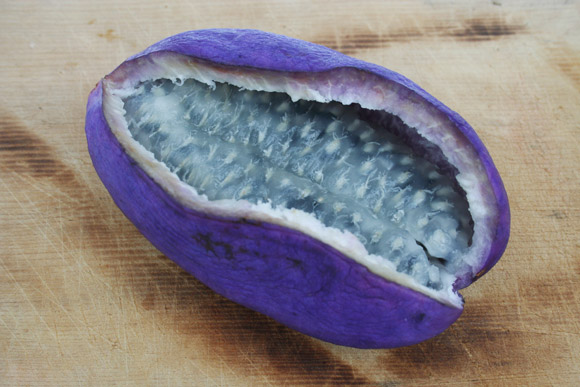
Cultivated Akebi, photo by Kyoto Foodie
Any plant with “chocolate” in the name is sure to get attention. And when it’s also called an invasive species then even more so.
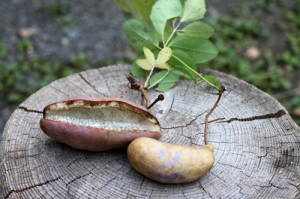
Wild Chocolate Vine Fruit, photo by Tsure Zure Gusa
Oddly the Chocolate Vine reminds me of the Camphor Tree. They are not even remotely related but when you read about the Camphor Tree it seems to have arrived everywhere from China in 1875, not 1874, not 1880, not 1896. Always 1875. Whether New York, San Francisco or Tampa, they all got a Camphor Tree in 1875. With the Chocolate Vine it’s 1845… everywhere…. London to New York… 1845… only in Asia in 1844 and everywhere else in 1845. While not impossible perhaps not probable. What we do know for certain is that it arrived in Britain from China in 1845. We know that because the Chocolate Vine was brought out of China by the most famous plant smuggler and secret agent of his day, a Scotsman called Robert Fortune.
Once Fortune got the Chocolate Vine to England it came to the United States, if not in 1845 then soon thereafter. Call that a training theft before the big heist because he then went back for all the tea in China, literally. It was Fortune who three years later single-handily smuggle tea plants and industry knowledge out of China — where the British had little influence — to India where they did. He did so by disguising himself as a Chinese peasant though he did not speak Chinese and knew nothing of botany. He also broke an agreement not to travel for more than a day’s journey from port cities. For the next 150 years India led the world in tea production. Only recently has China become the main producer of tea again. Fortune is why the British drink tea.
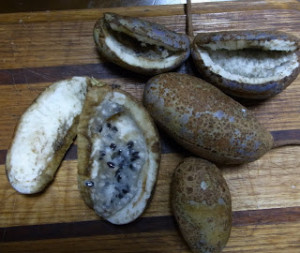
Wild “Akebi”ready for cooking, or eating raw. Photo by Ponkanchan
Most references are quick to say the Chocolate Vine produces an edible fruit but it doesn’t fruit often and isn’t interesting, as if to discredit any possible benefit this “invasive” might have. However, there is more to it. The mild, viscous pulp of the soft fruit is eaten raw with lemons juice or pureed and made into a cream or a drink. It has a slight coconut milk flavor. Young shoots are used in salads or for salt pickling. The bitter skin of the fruit is fried and eaten and the leaves used as a tea substitute. The empty pod is stuffed and deep fried. The fruit is also used to make wine. The seed oil is was used to make soap and as a vegetable oil. In fact the seeds are about 33% oil but on the bitter side. Most folks spit them out particularly the Japanese who view seeds in any food unappealing. The seeds, however, are edible. A relative, Akebia trifoliata, Mitsuba Akebi, is used in a similar way. Both are high in protein. A 70-gram serving of the fruit has 57 calories and 46mg of vitamin C. Akebi is also now cultivated as a crop in Japan providing a steady seasonal market.
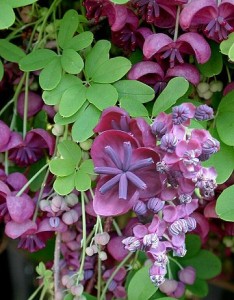
Chocolate Vine in Blossom, photo by valentine.gr
Botanically the Chocolate Vine is Akebia quinata (a-KEE-bee-uh kwi-NAY-tuh.) Akebia is the Dead Latin version of the native Japanese name, Akebi (AH-ke-bee.) Quinata means having five parts, in reference to the five-leaflet palmate leaves. It is in the quixotic Lardizabalaceae family, name for Miguel de Lardizabel y Uribem, a Spanish naturalist in the 1700s. The vine was scientifically classified by Brussels-born botanist Joseph Decaisne in the 1800s who used the Japanese name. Decaisne had gained some reputation in France for studying new plants from China. He was the natural choice to classify it. Fortune had called the species Rajania. Naive to Japan, Central China, and Korea it is found in Connecticut, District of Columbia, Georgia, Illinois, Indiana, Kentucky, Louisiana, Maryland, Massachusetts, Michigan, Missouri, North Carolina, New Jersey, New York, Ohio, Oregon, Pennsylvania, Rhode Island, South Carolina, Texas, Virginia, Washington state near Seattle. It is also invasive in New Zealand, southwest England, and threatening to become invasive in other parts of Europe.
Sometimes in Japan the purple-ripe version is called Murasaki Akebi, whereas a brown version is “Ishi Akebi” (stone akebi.) In Japanese the fruit is 通草, or 木通, though in native Hiragana it is あけび… (I lived in Japan a few years and would like to thank Avi Landau’s Tsukublog and Japan Homesteading.)
The Akebi is closely related to the Mube, or Stauntonia (Stauntonia hexaphylla) which also has an edible fruit except it does not split open when ripe. It is sometimes planted as an ornamental.
Green Deane’s Itemized Plant Profile: The Chocolate Vine
IDENTIFICATION: Akebia quinata , a twining vine green when young, turning brown with age, lenticels noticeable. Leaves palmately compound with up to five 1.5 to 3 inch long, oval leaflets, is deciduous to semi-evergreen to evergreen depending on the climate it is growing in. Flowers are fragrant and monoecious with both male ( 1/4 inch) and female blossoms (1 inch) on the same raceme, the aroma ranges from lightly chocolate to lilac to vanilla to allspice. Noses can’t agree. The dangling flowers produce fruit that resemble little egg plants. Seed pods purplish with white pulp, black seeds. Vine can grow to 40 feet long. There are five cultivated varieties. Alba: Vigorous with white flowers, Leucantha: White flowers, similar to Alba, Purple Bouquet: Most common in trade, desirable for its compact size, growing about half the height of other varieties, Rosea: Flowers are more pale than the unnamed species, helping them to stand out against the dark foliage, and Variegata: Showy splashes of white on foliage make an attractive backdrop for pink blossoms. Besides having a chocolate aroma (to some) the blossoms sometimes are also dusky in color hence a second reason for calling it the Chocolate Vine.
TIME OF YEAR: Flowers in mid-spring. Fruits September to October. Like apples in the northern United States ripening Akebi tell the Japanese fall has arrived.
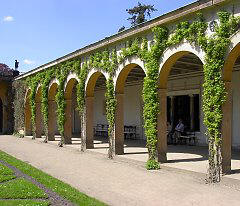
Akebi is often used for its vigorous growth, as here in Potsdam / Brandenburg, Castle Park Sanssouci, photo by Fassaden Grun
ENVIRONMENT: Grows easily in most soils, does best in well-drained sandy loam with regular moisture and full sun. Can form dense mats as an understory species. It can also climb and kill small trees and shrubs. In its native range it is found along forest edges, streams banks and mountain slopes. For best fruit production there should be more than one vine for good cross-pollination. Hand pollinating increases fruit production. They do not self-pollinate. Propagate by using tip layering or softwood stem cutting. From seed the plant takes five years to mature.
METHOD OF PREPARATION: When ripe the wild pods will look like purplish-blueish little mango-shaped eggplants that have been slit open. Pulp of the fruit eaten raw or made into a drink or wine, young shoots in salads or pickled with salt, bitter skin fried (often with miso) or cooked with sugar, leaves used as a tea substitute. The fruit dehydrates well whole. Pulp-less pods can be stuffed and deep fried. You can eat the seeds or spit them out. Better, plant them for edible shoots. Seeds of A. quinata usually germinate in one to three months at 59°F or 15°C. Medicinally sliced inner vine is used to make a diuretic. Young vines are used to make baskets.
Akebi Pod Miso Itame あけび みそ炒め by Kyoto Foodie
Ingredients
- 1 akebi pod (inner fruit removed)
- 2 tablespoons oil (sesame oil is nice)
- 1-2 teaspoon miso paste (same as for miso soup)
- 1 teaspoon sugar
- 1 teaspoon shoyu (Japanese soy sauce)
- 2 tablespoons of ryorishu (cooking sake or sake)
- shiso leaf (fresh green shiso leaf) optional
Use at least two teaspoons of Kansai-style sweet miso paste which is light in color. Tohoku style miso is red and saltier and you might want to go easy on the amount if you are using that style of miso. Adjust amount based on the kind of miso you are using and of course your taste.
Preparation
If you would like to remove some of the bitterness you can soak the pod halves or slices in warm water for 30 to 60 minutes. Pat dry before sauteing.
Mix all the liquid ingredients together in a bowl, dissolving the miso paste and sugar.
Heat a fry pan and add several tablespoons of oil. Once hot, add sliced akebi pod and saute covered until akebi softens, this should take about 2 minutes.
Pour in liquid ingredients, reduce heat and simmer down until little liquid remains. This should take 1 to 2 minutes. Due to the high sugar content, the mixture will quickly burn – don’t allow that to happen. Once the liquid has been reduced, serve on a plate and garnish with chopped shiso leaf.


